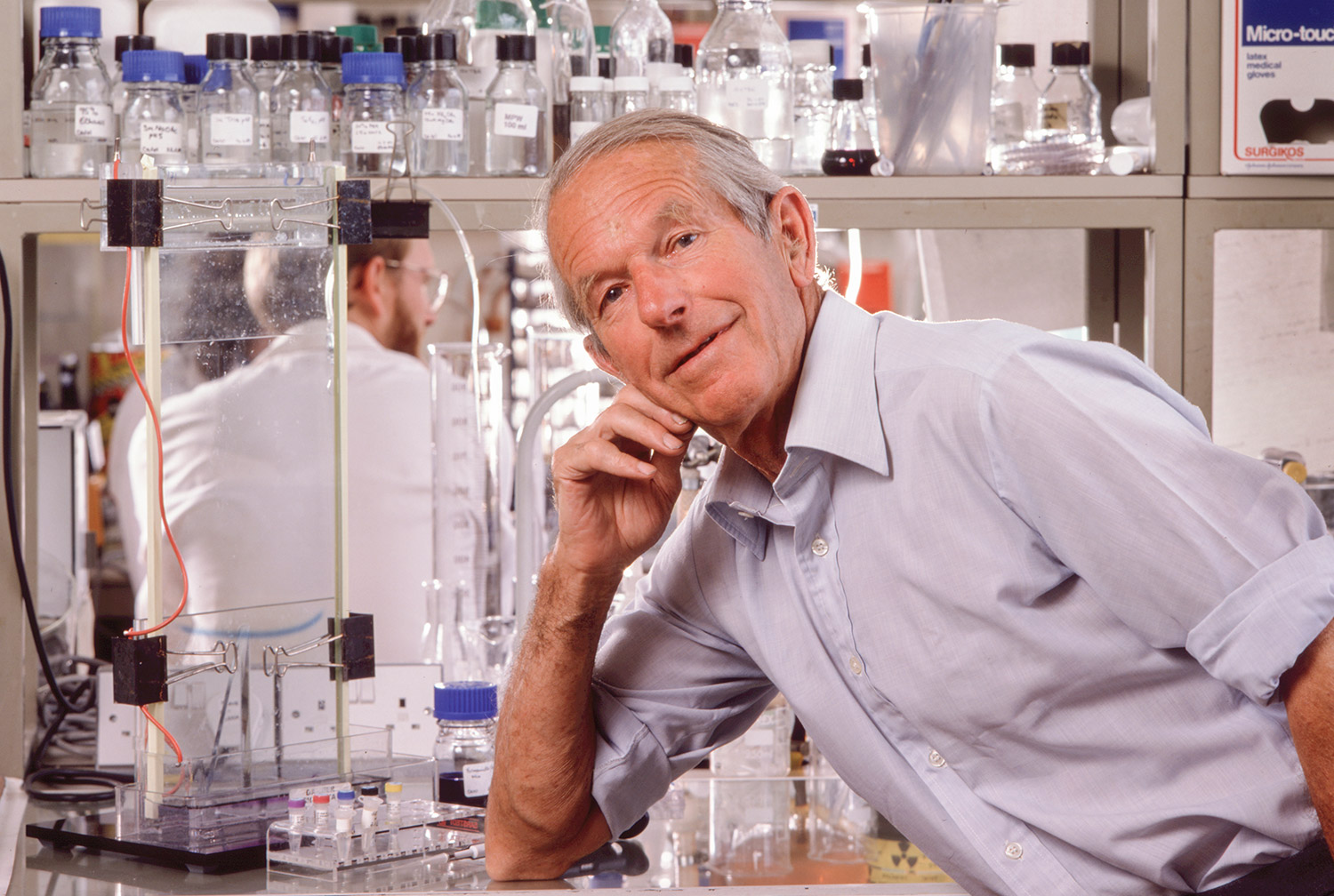By:
- Scott LaFee
Published Date
By:
- Scott LaFee
Share This:

biochemist Frederick Sanger
A Man of Letters, Carefully Sequenced
Noble laureates to gather at symposium honoring Frederick Sanger, whose genetics research left a legacy written in A-T-G-C
After a visit to UC San Diego in the early 1980s to give a lecture, the famed British biochemist Frederick Sanger was rewarded with a homemade T-shirt emblazoned with the letters DNA in sequins. It was the sort of joke only a person who studied genetics might immediately appreciate: DNA sequence, get it?
Sanger, of course, got the joke and reportedly wore the shirt often, telling friends he thoroughly enjoyed his visit to San Diego.
Alas, it was a one-time visit. Sanger never returned to UC San Diego, but his impact upon the university—indeed upon the science of genetics and its rippling, massive impact on society and life—have not been forgotten.
On Nov. 5, a daylong symposium in honor of Sanger will be held in the auditorium of the Medical Education/Telemedicine building on the School of Medicine campus. Sanger is best known for winning the Nobel Prize for chemistry twice, one of only two laureates to win in the same category. (The other was John Bardeen in physics.) He is only the fourth person to garner two Nobel Prizes (joining Bardeen, Marie Curie and Linus Pauling) and just the third to win two Prizes in the sciences (with Bardeen and Curie).
The list of symposium speakers reflects Sanger’s celebrated status. Three fellow Nobel laureates – David Baltimore (1975, physiology or medicine); Hamilton Smith (1978, physiology or medicine) and Roger Kornberg (2006, chemistry) will be in attendance, along with Stanley Norman Cohen, who is credited with co-inventing DNA cloning and recombinant DNA technologies.
There will be speakers from the Swedish Royal Academy, which awards the Nobel Prize; the University of Cambridge where Sanger worked and taught and closer to home, the Salk Institute for Biological Studies and the J. Craig Venter Institute.
The UC San Diego symposium is one of just a handful of events worldwide celebrating Sanger’s life (he died Nov. 19, 2013 at the age of 95) and his scientific legacy, which has profoundly affected UC San Diego’s rise as a leading research university in biological sciences.
“Fred did not have a close relationship with UC San Diego, but much of the scientific strength of this university and our sister institutions in La Jolla is built upon his work,” said Dr. Theodore Friedmann, a professor of pediatrics, a former student of Sanger’s, a pioneer himself in gene therapy and one of the symposium organizers. (It was Friedmann’s wife, Ingrid, who designed and made Sanger’s sequined DNA T-shirt.)
“We would not be where we are without Fred’s work. He has certainly been one of the principal inspirations of my own career. Our symposium pays homage not so much to any particular connection to UC San Diego, but to his service to the entire world of science.”
His first Nobel Prize, awarded in 1958, honored Sanger’s research describing the structure of proteins, in particular how amino acids linked together to form insulin.
In 1980, he shared half of the Nobel Prize for chemistry with American molecular biologist Walter Gilbert for their invention of a method to decipher the sequences of bases—adenine, thymine, guanine and cytosine, the A-T-G-C molecules essential to all life—in nucleic acids, most famously deoxyribonucleic acid (DNA) and ribonucleic acid (RNA). Paul Berg was awarded the other half for his research involving recombinant DNA.
Sanger’s twin Nobels augured the broader ramifications of his achievements.
By piecing together the chain of 51 amino acids that comprise insulin, Sanger showed scientists how to determine the sequences of other proteins.
By creating a method to read DNA simply and effectively, Sanger and colleagues made it possible to decode entire genomes. In 1977, Sanger decoded the genome of a virus – a first. Subsequent improvements and technological advances eventually made it possible for scientists in 2003 to successfully decipher the 3 billion letters that spell out the human genetic code.
“Sanger invented most of what underlies modern genetics and genomic science,” said Friedmann. “Fred was to genetics what Michelangelo and Picasso were to art, what Einstein is to physics and Darwin to evolutionary science. He was a giant among giants to whom most of us owe our careers.”
Scientific progress in biomedical research at institutions throughout the world has benefitted enormously from Fred’s revolutionary technologies, said Tony Hunter, a renowned Salk biologist who is an adjunct professor at UC San Diego and symposium co-organizer with Friedmann and Susan Taylor, professor of chemistry, biochemistry and pharmacology at UC San Diego.
“Rapid DNA sequencing is now pivotal in all areas of biology and medicine, but very few scientists who use this technology every day remember the crucial role that Fred Sanger played in making this a reality,” he said. “Perhaps it is a testament to the importance of what he did that his methods live on, but the man is largely forgotten!”
Sanger, who retired in 1983 to tend to his much-loved garden of roses and dahlias, would likely be a little dismayed by the symposium. Not the science, just the celebration. He was notably averse to publicity and never sought fame. He refused a knighthood from the Queen and, in his obituary, was quoted as describing himself as “just a chap who messed about in a lab.”
Maybe so, but his achievements are writ large in the letters of our DNA.
Share This:
You May Also Like
$10 Million Grant from Price Philanthropies Launches Behavioral Health Hub at UC San Diego Health
Health & BehaviorStay in the Know
Keep up with all the latest from UC San Diego. Subscribe to the newsletter today.



